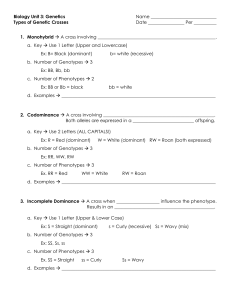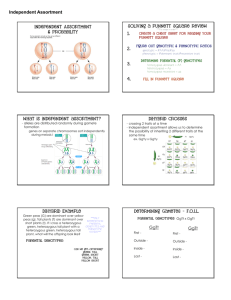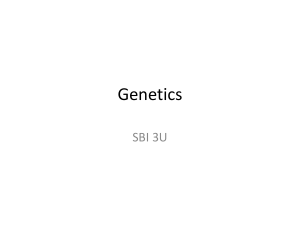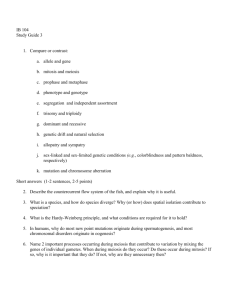Lecture 2 The Probability Problem from Wednesday Out of every
advertisement
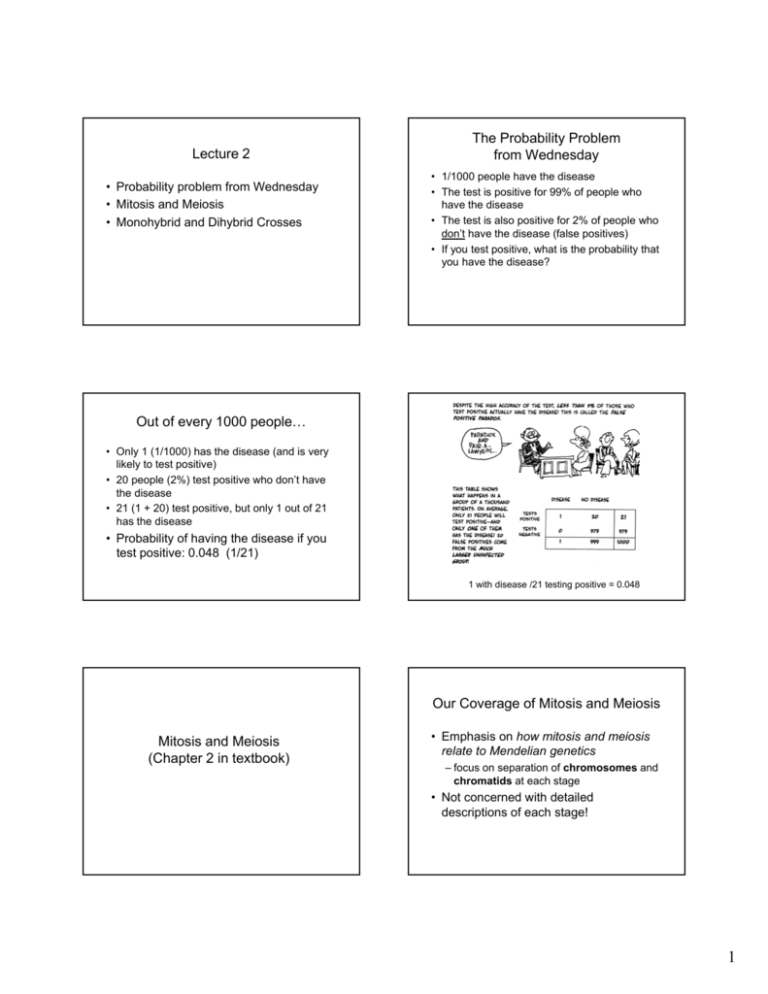
Lecture 2 • Probability problem from Wednesday • Mitosis and Meiosis • Monohybrid and Dihybrid Crosses The Probability Problem from Wednesday • 1/1000 people have the disease • The test is positive for 99% of people who have the disease • The test is also positive for 2% of people who don’t have the disease (false positives) • If you test positive, what is the probability that you have the disease? Out of every 1000 people… • Only 1 (1/1000) has the disease (and is very likely to test positive) • 20 people (2%) test positive who don’t have the disease • 21 (1 + 20) test positive, but only 1 out of 21 has the disease • Probability of having the disease if you test positive: 0.048 (1/21) 1 with disease /21 testing positive = 0.048 Our Coverage of Mitosis and Meiosis Mitosis and Meiosis (Chapter 2 in textbook) • Emphasis on how mitosis and meiosis relate to Mendelian genetics – focus on separation of chromosomes and chromatids at each stage • Not concerned with detailed descriptions of each stage! 1 Most plant and animal cells are diploid (2n)– they have two sets of chromosomes Most plant and animal gametes are haploid (n)– they have one set of chromosomes Members of the same species have the same number of chromosomes In humans, there are 23 chromosomes per haploid set: 22 autosomes plus 1 sex chromosome (X or Y) Chromosome with 1 chromatid A Single Chromatid Pair of homologous chromosomes Each with 2 chromatids A Pair of Homologous Chromosomes Long Arm Centromere Short Arm Think of Mitosis and Meiosis as Solutions to Problems Think of Mitosis and Meiosis as Solutions to Problems Starting with two sets of chromosomes (one from dad, one from mom) • Problem: During normal cell division make sure every cell gets both sets of chromosomes • Solution: Mitosis Chromosomes and Chromatids Starting with two sets of chromosomes (one from dad, one from mom) • Problem: During production of gametes (eggs and sperm), make sure every gamete gets one complete set of chromosomes (mix mom’s and dad’s) • Solution: Meiosis 2 Chromatid Duplication and Chromosome Division Chromatid Duplication and Chromosome Division 1 chromosome 1 chromosome 2 chromosomes 2 chromosomes 1 chromatid 2 chromatids 2 chromatids 2 chromatids Mitosis: Each daughter cell receives a chromatid Mitosis is cell division that provides each daughter cell with a full set of chromosomes. • Before mitosis, each chromosome consists of two identical chromatids, attached at the centromere 2 chromosomes 4 chromatids • During mitosis, each chromosome divides into two identical single-chromatid chromosomes 2 chromosomes 2 chromatids • Each daughter cell receives one of the two chromatids/chromosomes. Meiosis • Provides each daughter nucleus with a single haploid set of chromosomes • The products of meiosis are typically gametes (eggs and sperm) • Before meiosis, there is a diploid number of chromosomes and each chromosome consists of two chromatids • After meiosis, there is a haploid set of chromosomes and each chromosome consists of one chromatid Meiosis: Before and After • Before: – diploid number of chromosomes – (e.g. for humans, 46) – each chromosome has two chromatids • After: – haploid set of chromosomes (e.g. 23) – each chromosome consists of one chromatid 3 Meiosis Consists of Two Divisions • The first divides pairs of homologous chromosomes • The second divides sister chromatids II Pair of homologous chromosomes I Blue – paternal (from dad) Pink – maternal (from mom) The first division separates pairs of homologous chromosomes The second divides sister chromatids Meiosis with two pairs of chromosomes Fertilization The first division separates pairs of homologous chromosomes • Gametes combine to form a zygote • Chromosomes from gametes are combined in the zygote’s nucleus (zygote is diploid) The second divides sister chromatids Mendel's Peas Some traits that Mendel studied • Varieties of peas that differed in obvious traits • Each variety of pea was inbred by selfing and pure breeding (offspring looked like parents) • Mendel crossed the different varieties and observed how the traits were inherited 4 The Monohybrid Cross • A cross between two varieties that differ in one trait • Parent are homozygous (two copies of the same allele) for the gene that controls the trait • Each parent is homozygous for a different allele Generations in Cross • • • • P – Parental generation F1 – first generation of progeny F2 – progeny of the progeny backcross –progeny crossed with a parent Example of Monohybrid Cross X Green pods GG Yellow pods gg All green pods Gg Inheritance of pod color demonstrates dominance • Often (but not always), phenotype of heterozygote is the same as one of the homozygotes – Example: A pod color heterozygote (Gg) looks like a green pod homozygote (GG) • The allele that controls the phenotype in a heterozygote is the dominant allele, the other is the recessive allele – Green pod allele is dominant, yellow pod allele is recessive Simple* Genotype Abbreviations • Dominant alleles are abbreviated by upper case letters – G for green pod allele • The recessive allele uses the same letter, but lower case – g for yellow pod allele • Diploid genotypes are abbreviated with two letters, with dominant alleles listed first – GG for a green pod homozygote – Gg for a heterozygote – gg for a yellow pod homozygote *These rules only hold for simple cases! 5 Summary of First Generation of Monohybrid Cross • P generation: each individual is homozygous for a different allele • Gametes of a homozygous parent carry one copy of the allele the parent is homozygous for • F1 generation – starts with zygote, heterozygous for alleles from parents Second generation of monohybrid cross is either… • heterozygous individuals crossed with each other, or • heterozygous individuals self-fertilized 6 Mendel’s Principle of Segregation • Each individual has two alleles (example Gg) • During reproduction, alleles separate (“segregate”) and only one is passed on to each offspring (each offspring gets either G or g) Monohybrid Cross Diagram with Gametes P Gametes F1 GG G x gg g Self-fertilization (“Selfing”) • Selfed lines breed true because they are homozygous GG x GG crosses produce all GG progeny gg x gg crosses produce all gg progeny • In selfing, only heterozygotes produce more heterozygotes, and half their progeny are homozygotes Gg Gg x Gg crosses produce ½ Gg progeny F1 Gametes F2 Gg x ½G ½g ¼ GG ½ Gg Gg ½G ½g ¼ gg • Each generation the proportion of heterozygotes to decreases by ½ • As the proportion of heterozygotes gets very small, it is likely that by chance it will reach zero • Eventually all plants are homozygotes (GG or gg); each homozygous line is a different pure-breeding line Backcross • Cross between progeny and parental genotype • Example: P: F1: Backcrosses are: GG x gg Gg Gg x GG or Test Cross: A cross to find out the genotype of a dominant phenotype • Individuals with dominant phenotypes may be either homozygotes or heterozygotes Gg x gg F1 produces two types of gametes: G and g P produces only one type of gamete Proportions of genotypes in progeny are ½ to ½ Gg x GG cross: ½ GG and ½ Gg (all green pods) Gg x gg produces ½ Gg and ½ gg (½ green, ½ yellow) • A test cross is used to determine the unknown genotype • Unknown individual is crossed with a homozygous recessive 7 Test Cross Example F2 from monohybrid cross has Green Pods. Genotype?? • It could be either GG or Gg • To find out: cross it with a gg (yellow pod) plant If the unknown plant is GG the cross is: GG x gg All the progeny from the test cross are Gg – green pods If the unknown plant is Gg the cross is: Gg x gg Half of the progeny are Gg (green),and half are gg (yellow) Mendel’s Principle of Independent Assortment • Only applies to crosses with multiple (two or more) genes • Alleles of different genes assort independently of one another during gamete formation • Independent assortment means that alleles from different genes are inherited independently Dihybrid Cross Diagram of Dihybrid Cross with Green/Yellow Pods and Tall/Short Height Cross between 2 pure breeding varieties that differ for 2 traits Generation Genotypes Phenotypes P GGTT x ggtt Green, Tall Yellow, Short Each trait is controlled by a separate gene (locus) Each gene (locus) has two alleles Gametes Trait Pod Color Height Alleles G - green (dominant) g - yellow T - tall (dominant) t - short There are 16 (4 x 4) Possible Gamete Combinations GT F1 gt GgTt Green, Tall GgTt x GgTt All combinations of gametes are equally likely because they are independently assorted ¼ GT ¼ Gt ¼ gT ¼ gt Gamete1 Gamete2 Genotype Phenotype GT GT GGTT Green, Tall “ Gt GGTt Green, Tall “ gT GgTT Green, Tall “ gt GgTt Green, Tall Gt GT GGTt Green, Tall Green, Short “ Gt GGtt “ gT GgTt Green, Tall “ gt Ggtt Green, Short gT GT GgTT Green, Tall “ Gt GgTt Green, Tall “ gT ggTT Yellow, Tall “ gt ggTt Yellow, Tall gt GT GgTt Green, Tall “ Gt Ggtt Green, Short “ gT ggTt Yellow, Tall “ gt ggtt Yellow, Short 8 Gamete1 Gamete2 Genotype Phenotype GT GT GT GGTT Green, Tall 1 “ Gt GGTt Green, Tall 2 “ gT GgTT Green, Tall 3 “ gt GgTt Green, Tall 4 Gt GT GGTt Green, Tall 5 “ Gt GGtt Green, Short “ gT GgTt Green, Tall “ gt Ggtt Green, Short gT GT GgTT Green, Tall 7 8 “ Gt GgTt Green, Tall “ gT ggTT Yellow, Tall “ gt ggTt Yellow, Tall gt GT GgTt Green, Tall “ Gt Ggtt Green, Short “ gT ggTt Yellow, Tall “ gt ggtt Yellow, Short Gt gT gt Expected Proportions in Dihybrid Cross Green, Tall (Dominant for both) Yellow, Tall (Dominant for one) Green, Short (Dominant for other) Yellow, Short (Recessive for both) 1 6 2 1 2 9 3 3 Punnett Squares • Useful for simple problems, but not for the more complex ones we will be working with soon • If you understand probabilities you do not need to use a Punnett square !!! We define an event as something that may happen with a certain probability We use the following abbreviation for the probability of an event: Pr (event) 9/16 3/16 3/16 1/16 1 Probability & Statistics • Probabilities of events • Complex events • Conditional probability The probability of an event is the proportion of times that it will happen 1. Probability of flipping a coin and getting heads is 0.5 Pr (heads) = 0.5 2. Probability of a baby being a boy (for our purposes) is 0.5 Pr (boy) = 0.5 9 Probability values are always between 0 and 1 Killed by a shark: 1 in 350 million (0.0000000029) 1. A probability of 0 means the event will never happen 2. A probability of 1 means the event will always happen 3. Since events can’t happen less often than never, or more often than always, all events have probabilities between 0 and 1 Probabilities for Some Events Happening to Someone this Year Killed by a dog: 1 in 18 million (0.0000000556) • • • • Killed by a shark Killed by a dog Killed in an airline crash Killed by lighting 1 in 350 million 1 in 18 million 1 in 7.7 million 1 in 4.2 million 0.0000000029 0.0000000556 0.0000001299 0.0000002381 Probabilities for Some Events Happening to Someone this Year A guy dating a supermodel: 1 in 88,000 (0.0000113636) • • • • • • Killed by a shark Killed by a dog Killed in an airline crash Killed by lighting Date a Supermodel Killed in an auto accident 1 in 350 million 1 in 18 million 1 in 7.7 million 1 in 4.2 million 1 in 88,000 1 in 6,200 0.0000000029 0.0000000556 0.0000001299 0.0000002381 0.0000113636 0.0001612903 10 A single coin toss is a simple event with a known probability Probability of an Event An event happens with a certain probability Abbreviation for the probability of an event: However we usually need to know the probabilities of more complex events that are combinations of simple events Probability of Event Not Happening Pr (not A) = 1-Pr(A) Example: Pr (Heads) = ½ Pr (not Heads) = 1 – ½ = ½ In some cases, we need to know the probability that either of two mutually exclusive events will occur Pr (event) Probability of flipping a coin and getting heads is 0.5 Pr (heads) = 0.5 A single coin toss is a simple event with a known probability However we usually need to know the probabilities of more complex events that are combinations of simple events Venn Diagram of Mutually Exclusive Events By mutually exclusive, we mean events that could not possibly happen at the same time For example: head and tails are mutually exclusive what is Pr (heads or tails) ? 11 Two Possible Paths… We call such complex events unions of simple events. 1/2 For unions, we add the probabilities of the events: 1/2 Pr (either A or B) = Pr(A) + Pr(B) Start here Example 2 1/2 1/2 Pr (single dice roll is a 1 or a 2 ) Pr (Heads OR Tails) = ½+½=1 Six possibilities, all with Pr = 1/6 Calculate: Pr (single die roll is a 1 or a 2 ) Pr (dice comes up 1) = 1/6 Pr (dice comes up 2) = 1/6 Pr (dice comes up 1 or 2) = 1/6 + 1/6 = 2/6 = 1/3 12 What is the Probability of rolling one die and having it not come up either 1 or 2? Pr (not (1 or 2)) = ? Pr (not (1 or 2)) = 1 – Pr(1 or 2) = 1 – 1/3 = 2/3 In other cases we need to know the probability of two events happening together We call such complex events intersections of simple events For intersections, we multiply the probabilities of the simple events Pr (both A and B) = Pr (A) x Pr (B) We can rephrase this as: Example of intersection: Pr (two babies are both boys) =? Pr(first baby is a boy AND second baby is a boy) Pr (first baby is a boy) = 1/2 Pr (second baby is a boy) = 1/2 Pr (first baby is a boy and second is a boy) = 1/2 x 1/2 = 1/4 Venn Diagram 13
